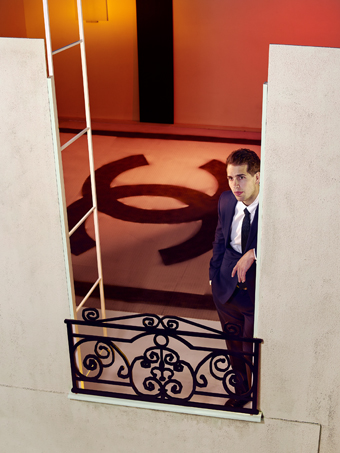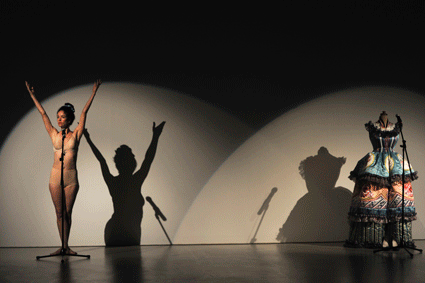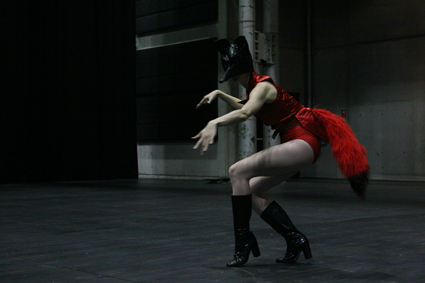Fashioning art
In his seminal text, The Fashion System (1967), Roland Barthes breaks fashion into two forms—image-clothing and written clothing. In the 21st century might we not extend this to clothing performed, musical and virtual?
For Profiler 5 we’ve asked some impeccably attired artists how they view fashion; how fashion influences their work; and their thoughts on the slippage of fashion into art and art into fashion.
Gail Priest, Online Producer
Darren Sylvester | Elizabeth Ryan | Lian Loke | Laura Jane Lowther | Ivan Cheng
Darren Sylvester, Dreams End With You, 2014
courtesy Sullivan+Strumpf, Sydney
Darren Sylvester, Dreams End With You, 2014
Darren Sylvester, visual artist
When overseas, one of the main activities I do is shopping. And by that I mean I like to walk through high-end malls and flagship stores. I get a lot of inspiration from them. It doesn’t mean I buy anything, although on occasions of course I will. One of the attractions is the holistic world of branding. A concentrated world. A considered, complete world. I enjoy the finishing of a shop fit out: the colouring, carpets, discrete lighting, packaging, scents, music, security guards, hangers, glass and brass cabinets. Mirrors and reflections.
My recent photograph, Dreams End With You, displays a man perhaps looking up to the stars from within a Chanel store I made from plywood, laser cut MDF and spray painted carpet from Bunnings. The work originated from my own life very specifically. I was in Hong Kong, it was dusk and I was in a Chanel store that overlooked the city. With all that brand behind me, air-conditioned air around me and thick carpet beneath, I stood looking out into the night sky. I was daydreaming. The words ‘Dreams End With You’ went through my mind and I made a note of them on my phone.
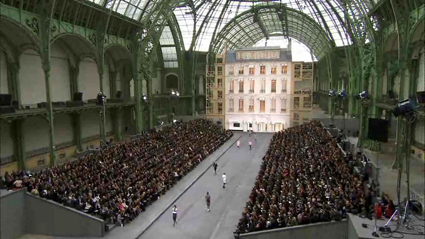
Chanel Spring Runway Show set, 2009
Soon after I saw the Chanel Spring Runway Show from 2009; the set was a re-construction of Coco Chanel’s apartment in Paris, which in turn has become the template for all new Chanel stores. I remade that moment of me standing in the window, however this time I modelled the store on the reconstructed runway show. It is a copy of a copy. A dream from a dream.
http://sullivanstrumpf.com/artists/sylvester-darren/
Selected articles
Love might not come easily to art, but…
Ella Mudie: We Used To Talk About Love
RealTime issue #114 April-May 2013 pg.
Love refractually
Urszula Dawkins: Project 12: This Is Not A Love Song
RealTime issue #108 April-May 2012 pg. 44
Elizabeth Ryan, I Was Made for Loving You, dress by Romance was Born
photo Heidrun Löhr
Elizabeth Ryan, I Was Made for Loving You, dress by Romance was Born
Elizabeth Ryan, dancer
The big question (for some of us) of what to wear in a piece is a consideration that comes pretty early on in my creative process. I love exploring the potential a costume has to be a significant contributor. This theme is very evident in my work with The Fondue Set and has continued in the development of my solo practice.
When I was given the opportunity to collaborate with the design team Romance Was Born, as part of an interdisciplinary residency at the Campbelltown Arts Centre in 2012, I was very excited but also somewhat intimidated. Much as I love a good costume, I hadn’t necessarily connected that with fashion. My perception of fashion was that it was from a particular ‘cool’ world of design, form, desirability and status. Combining this with what I knew of the work of Romance Was Born, I anticipated I would be met by a creation that would be highly desirable, evocative and a powerful presence in a theatrical setting. What a gift! However I found myself questioning how my body, my movement and my performance could meet all that.
In the resulting performance, I Was Made for Loving You, I chose to play with removing myself from the costume by wearing a highly undesirable beige bra and undies. Putting my unfashionable and exposed self in relationship to this item of immense beauty and intrigue created a palpable tension which led to the work feeling more like a duet than a solo. I pursued the power play for dominance, attention and status in the space between my performing body and ‘the dress’ as it became known, at times performing as if wearing the dress or ‘performing the dress’ and at other times making a contrasting state of exposure and vulnerability more visible.
My intimidation turned out to be short-lived. In my book fashion makes for a fabulous dance partner.
http://www.thefondueset.com.au/about
Selected articles
Oh how they danced!
Virginia Baxter: Oh I Wanna Dance With Somebody
RealTime issue #112 Dec-Jan 2012 p2-3
Nothing to lose
Keith Gallasch: The Fondue Set’s No Success Like Failure
RealTime issue #86 Aug-Sept 2008 p36
Glamorous calamities
David Williams: The Fondue Set, The Set (Up)
RealTime issue #64 Dec-Jan 2004 p35
Lian Loke, Fox, Underbelly 2007
photo Samantha Hanna
Lian Loke, Fox, Underbelly 2007
Lian Loke, performer, designer and researcher
The theatricality of fashion seduced me as a teenager and continues to provide a platform for creating characters and worlds accessed by the mere donning of a garment. I understand fashion not so much as the latest style of clothing, but as an opportunity to re-fashion or re-invent oneself. The relationship between the garment and the body fascinates me and has led to an exploration of performative clothing, beyond everyday fashion. The reshaping of silhouette, posture, comportment and sensibility through what is worn on the body can break down the conventions of dress and behaviour, opening the body up to creative exploration.
In my performance practice, costume plays an important role and I often begin with a strong vision of a costumed body. The costume becomes a prop or environment, activating the space between and creating spatial, sensory and movement vocabulary. The costume operates as a portal to other worlds. It enables an exploration of body and becoming, of the transformative potential of the imagination.
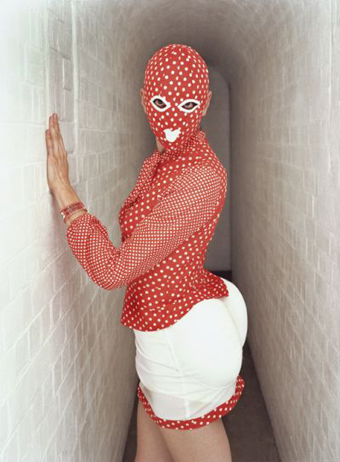
Lian Loke, Hyperfeminoid
photo Ian Tatton
Lian Loke, Hyperfeminoid
These ideas are present in my performative costumes Hyperfeminoid and Fox. Both of these works explore constructions of femininity and our ability to transgress the border between human and animal. I also draw on Shamanic, Daoist and Butoh movement and energy practices to inform the physical language for performance. These practices can help to access altered states of consciousness where the body moves in unfamiliar and usually inaccessible ways. The Fox is in a state of gradual evolution, each performance adding to its self-fashioning. The next project will start with a prosthetic approach to its feet, replacing the fetish of a high-heeled shoe with a delicate faux pas.
http://www.lianloke.com/
Selected articles
Interactive feedback
Lizzie Muller on how to prototype an artwork
RealTime issue #76 Dec-Jan 2006 p24
The body as lived
Mike Leggett: Thinking Through the Body
RealTime issue #93 Oct-Nov 2009 p31
A once and future building
Jodie McNeilly witnesses The Stirring at Carriageworks
RealTime issue #82 Dec-Jan 2007 p29
Laura Jane Lowther, KUČKA
When it comes to high fashion, I’m particularly drawn to the more avant-garde designers. I love dressing up and getting to be another character for a little while so it makes sense to me that the clothing should be unusual or different somehow to what you would expect to see in everyday life. One of my favourite eccentric designers, Walter Van Beirendonck (who is best known as part of the Antwerp Six) was a major influence in the look of our first music video “Rewind.”
Van Beirendonck designs are always bold, colourful and reminiscent of childhood imagery and we thought that the arpeggiated synths and percussion tones in the track were shapely and ‘colourful’ and quite similar to his style. We worked with Perth designer Zoe Trotman to make the dress. She had previously designed the donut dress, as part of her Lonely 8 bit Heroes collection, but we decided to add the dome shaped skirt on the bottom, to create a more striking shape, which a friend laser cut out of plastic for us. The main thing that drew us to Zoe’s design was the playful way she had stitched assorted plastic objects (including candy and donuts) onto the dress. We were playing with the idea of the over sexualised anime character and the cutesy candy theme really worked.
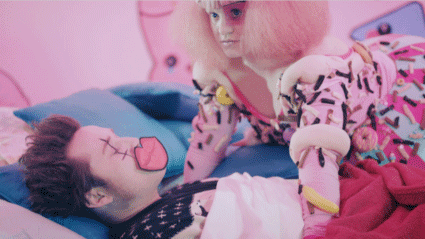
KUCKA, Rewind (video stills)
courtesy the artist
KUCKA, Rewind (video stills)
I always collaborate with my good friend Jessica Small who is a hairdresser but also an artist and watching her work has made me really appreciate how creative styling can be. She has worked on all of the KUČKA video clips and photo shoots and is often the one who refines the stylistic vision of the shoot. Jess decided to go all out with the styling for Rewind, painting Jake’s face and making my hairstyles as big as we could get, even fixing a photo frame into my hair for one of the scenes!
http://kucka.net
Ivan Cheng, performer/artist
Now, like all foreseeable time, is a ripe moment to be an advocate for feminist politics.
Connie has a pseudonym, and in conversation she expresses no desire to live abroad; after all, Kawakubo and Margiela detach from home. I’ve been abroad since May—a residency at the Watermill Center (NY) with director Tilman Hecker, a clarinet gig in London, a residency and exhibition in Saint-Chinian, France (open through 2015), and then playing clarinet in Martin del Amo’s Anatomy of an Afternoon at Southbank in London. Now I’m back at the Watermill Center for a third summer, and, as well as questioning my taste for fizzy water over flat, I am thinking about camouflage.
When in conversation about work, the issues of transference to image or text are alarming. There is always so much labour visible in documentation and reproduction; it fails to be invisible. In disguise of my work, I’m not sure what is lost. I studied the clarinet but spend time in other pursuits.
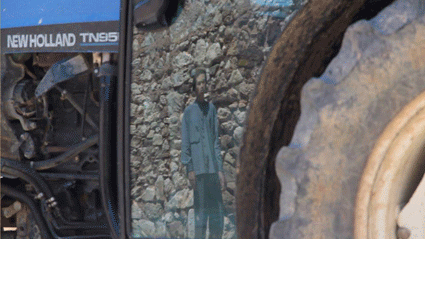
1) Ivan cheng in video still from gargoyles – deinstalled video from three gorges 2) Installation view of three gorges
courtesy the artist
1) Ivan cheng in video still from gargoyles – deinstalled video from three gorges 2) Installation view of three gorges
My work has been interested in the act of reading for a while now and a constant is how a ‘score’ is damaged upon transference into plane. As part of Little Operations, Chamber Made Opera will present a remount of a work of mine titled kelley-gander-floyer at Deakin Edge in Melbourne. A score for 100 performers in my likeness aggregating over 65,000 words of text into an hour-long space, it contains and begins to represent the music of James Brown, Austin Buckett, Lachlan Hughes and Marcus Whale, This score formed the first stage development of epoche-lacan-orbits, commissioned over three years by Carriageworks. In Melbourne, the work will be performed by a small group of children.
http://ivancheng.com
RealTime issue #121 June-July 2014 pg. web


